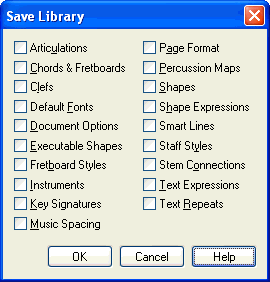|
L'aide française est disponible au format PDF en cliquant ici (ou dans le Menu "Démarrer", Finale 2010, Documentation PDF française)
Le tutoriel français est disponible au format PDF en cliquant ici.
La mise à jour de l'aide française au format HTML sera disponible prochainement.
|
Traduction française :

|
Save Library dialog box

How to get there
Choose Save Library from the File menu. Or, from the Document menu, choose Document Options and click the Save Library button.
What it does
In the course of working on scores, you may create your own markings and symbols. Finale allows you to save these musical elements (articulations, chord symbols, and so on) into separate files called libraries. These sets of musical elements may then be "loaded into" any document.
This dialog box lets you specify which elements of your document you want to save into a library.
- [Library Types]: A summary of the options listed in this dialog box appears below. Click the radio button of the element of the currently open document you want to save separately.
Articulations: One-character articulation or other musical markings (accent, fermata, and so on) created with the Articulation Tool.
Chords & Fretboards: Chord suffixes you’ve created or edited with the Chord Tool, including chords you’ve "taught" Finale to recognize. This library also saves any custom fretboards you’ve created. Finale will check for duplicate suffixes and only load new unique chord suffixes.
Clefs: Eighteen clefs, which you can edit in the Clef Designer. Clef libraries include accidental placements for major and minor keys.
Default Fonts: Font choices for many aspects of the score, as found in Document Options-Fonts (from the Document menu, choose Document Options, then Fonts).
Document Options: Finale settings having to do with the active document, including almost every setting in the Document menu (such as clefs, music characters, PostScript settings, line widths, and so on).
Executable Shapes: Any Executable Shapes you’ve created with the Shape Designer and Executable Shape Designer.
Fretboard Styles: Settings that determine how Finale draws custom fretboards, such as number of frets, string spacing, and fret number font. See Fretboard Styles dialog box.
Instruments: A set of staff-to-MIDI relationships for your particular MIDI setup, as established in the Instrument List Window.
Key Signatures: Any nonstandard key signatures you create with the Key Signature Tool.
Music Spacing: Saves settings from Document Options-Music Spacing dialog box.
Page Format: Saves settings from the Page Format for Score and Page Format for Parts dialog boxes.
Percussion Maps: Maps you’ve created with the Staff Tool in the Percussion Map Designer.
Shapes: Anything you’ve drawn in the Shape Designer, including multimeasure rests, custom stem shapes, fonts, as well as the "raw shapes" that form the basis of and Executable Shapes.
Shape Expressions: Expressions consisting of a shape drawn in the Expression Designer (and a related playback definition).
Smart Lines: Custom Smart Shapes defined in the Smart Line Style dialog box.
Staff Styles: Staff Styles, such as slash notation or transpositions, created with the Staff Tool.
Stem Connections: Adjustments to how the stem attaches to specific noteheads. See Stem Connection Editor dialog box.
Text Expressions: Expressions consisting of text (and a related playback definition): "Allegro," "ritard," and so on in the Expression Designer.
Text Repeats: Text repeats, such as "To Coda," created with the Repeat Tool.
- OK • Cancel. Once you’ve chosen the element of your piece for which you want to create a library, click OK. Finale asks you to title the new library; the next time you’re working on a piece that requires the contents of that library, you can simply load it using the Load Library command. Click Cancel if you decide not to create a new library. You return to the score.
See Also:
File menu


